Adnan Shahid
Foundation Model for Wireless Technology Recognition Using IQ Timeseries
May 26, 2025Abstract:Wireless Technology Recognition (WTR) is essential in modern communication systems, enabling efficient spectrum management and the seamless coexistence of diverse technologies. In real-world conditions, WTR solutions should be able to handle signals from various resources with different sampling rates, capturing devices, and frequency bands. However, traditional WTR methods, which rely on energy detection, Convolutional Neural Network (CNN) models, or Deep Learning (DL), lack the robustness and adaptability required to generalize across unseen environments, different sampling devices, and previously unencountered signal classes. In this work, we introduce a Transformer-based foundation model for WTR, trained in an unsupervised manner on large-scale, unlabeled wireless signal datasets. Foundation models are designed to learn general-purpose representations that transfer effectively across tasks and domains, allowing generalization towards new technologies and WTR sampling devices. Our approach leverages input patching for computational efficiency and incorporates a two-stage training pipeline: unsupervised pre-training followed by lightweight fine-tuning. This enables the model to generalize to new wireless technologies and environments using only a small number of labeled samples. Experimental results demonstrate that our model achieves superior accuracy across varying sampling rates and frequency bands while maintaining low computational complexity, supporting the vision of a reusable wireless foundation model adaptable to new technologies with minimal retraining.
Wi-Fi 6 Cross-Technology Interference Detection and Mitigation by OFDMA: an Experimental Study
Mar 07, 2025Abstract:Cross-Technology Interference (CTI) poses challenges for the performance and robustness of wireless networks. There are opportunities for better cooperation if the spectral occupation and technology of the interference can be detected. Namely, this information can help the Orthogonal Frequency Division Multiple Access (OFDMA) scheduler in IEEE 802.11ax (Wi-Fi 6) to efficiently allocate resources to multiple users inthe frequency domain. This work shows that a single Channel State Information (CSI) snapshot, which is used for packet demodulation in the receiver, is enough to detect and classify the type of CTI on low-cost Wi-Fi 6 hardware. We show the classification accuracy of a small Convolutional Neural Network (CNN) for different Signal-to-Noise Ratio (SNR) and Signal-to-Interference Ratio (SIR) with simulated data, as well as using a wired and over-the-air test with a professional wireless connectivity tester, while running the inference on the low-cost device. Furthermore, we use openwifi, a full-stack Wi-Fi transceiver running on software-defined radio (SDR) available in the w-iLab.t testbed, as Access Point (AP) to implement a CTI-aware multi-user OFDMA scheduler when the clients send CTI detection feedback to the AP. We show experimentally that it can fully mitigate the 35% throughput loss caused by CTI when the AP applies the appropriate scheduling.
Large-Scale AI in Telecom: Charting the Roadmap for Innovation, Scalability, and Enhanced Digital Experiences
Mar 06, 2025Abstract:This white paper discusses the role of large-scale AI in the telecommunications industry, with a specific focus on the potential of generative AI to revolutionize network functions and user experiences, especially in the context of 6G systems. It highlights the development and deployment of Large Telecom Models (LTMs), which are tailored AI models designed to address the complex challenges faced by modern telecom networks. The paper covers a wide range of topics, from the architecture and deployment strategies of LTMs to their applications in network management, resource allocation, and optimization. It also explores the regulatory, ethical, and standardization considerations for LTMs, offering insights into their future integration into telecom infrastructure. The goal is to provide a comprehensive roadmap for the adoption of LTMs to enhance scalability, performance, and user-centric innovation in telecom networks.
Bluetooth Low Energy Dataset Using In-Phase and Quadrature Samples for Indoor Localization
Dec 02, 2024Abstract:One significant challenge in research is to collect a large amount of data and learn the underlying relationship between the input and the output variables. This paper outlines the process of collecting and validating a dataset designed to determine the angle of arrival (AoA) using Bluetooth low energy (BLE) technology. The data, collected in a laboratory setting, is intended to approximate real-world industrial scenarios. This paper discusses the data collection process, the structure of the dataset, and the methodology adopted for automating sample labeling for supervised learning. The collected samples and the process of generating ground truth (GT) labels were validated using the Texas Instruments (TI) phase difference of arrival (PDoA) implementation on the data, yielding a mean absolute error (MAE) at one of the heights without obstacles of $25.71^\circ$. The distance estimation on BLE was implemented using a Gaussian Process Regression algorithm, yielding an MAE of $0.174$m.
High-Throughput Blind Co-Channel Interference Cancellation for Edge Devices Using Depthwise Separable Convolutions, Quantization, and Pruning
Nov 19, 2024Abstract:Co-channel interference cancellation (CCI) is the process used to reduce interference from other signals using the same frequency channel, thereby enhancing the performance of wireless communication systems. An improvement to this approach is blind CCI, which reduces interference without relying on prior knowledge of the interfering signal characteristics. Recent work suggested using machine learning (ML) models for this purpose, but high-throughput ML solutions are still lacking, especially for edge devices with limited resources. This work explores the adaptation of U-Net Convolutional Neural Network models for high-throughput blind source separation. Our approach is established on architectural modifications, notably through quantization and the incorporation of depthwise separable convolution, to achieve a balance between computational efficiency and performance. Our results demonstrate that the proposed models achieve superior MSE scores when removing unknown interference sources from the signals while maintaining significantly lower computational complexity compared to baseline models. One of our proposed models is deeper and fully convolutional, while the other is shallower with a convolutional structure incorporating an LSTM. Depthwise separable convolution and quantization further reduce the memory footprint and computational demands, albeit with some performance trade-offs. Specifically, applying depthwise separable convolutions to the model with the LSTM results in only a 0.72% degradation in MSE score while reducing MACs by 58.66%. For the fully convolutional model, we observe a 0.63% improvement in MSE score with even 61.10% fewer MACs. Overall, our findings underscore the feasibility of using optimized machine-learning models for interference cancellation in devices with limited resources.
Error Mitigation for TDoA UWB Indoor Localization using Unsupervised Machine Learning
Apr 10, 2024Abstract:Indoor positioning systems based on Ultra-wideband (UWB) technology are gaining recognition for their ability to provide cm-level localization accuracy. However, these systems often encounter challenges caused by dense multi-path fading, leading to positioning errors. To address this issue, in this letter, we propose a novel methodology for unsupervised anchor node selection using deep embedded clustering (DEC). Our approach uses an Auto Encoder (AE) before clustering, thereby better separating UWB features into separable clusters of UWB input signals. We furthermore investigate how to rank these clusters based on their cluster quality, allowing us to remove untrustworthy signals. Experimental results show the efficiency of our proposed method, demonstrating a significant 23.1% reduction in mean absolute error (MAE) compared to without anchor exclusion. Especially in the dense multi-path area, our algorithm achieves even more significant enhancements, reducing the MAE by 26.6% and the 95th percentile error by 49.3% compared to without anchor exclusion.
Removing the need for ground truth UWB data collection: self-supervised ranging error correction using deep reinforcement learning
Mar 28, 2024Abstract:Indoor positioning using UWB technology has gained interest due to its centimeter-level accuracy potential. However, multipath effects and non-line-of-sight conditions cause ranging errors between anchors and tags. Existing approaches for mitigating these ranging errors rely on collecting large labeled datasets, making them impractical for real-world deployments. This paper proposes a novel self-supervised deep reinforcement learning approach that does not require labeled ground truth data. A reinforcement learning agent uses the channel impulse response as a state and predicts corrections to minimize the error between corrected and estimated ranges. The agent learns, self-supervised, by iteratively improving corrections that are generated by combining the predictability of trajectories with filtering and smoothening. Experiments on real-world UWB measurements demonstrate comparable performance to state-of-the-art supervised methods, overcoming data dependency and lack of generalizability limitations. This makes self-supervised deep reinforcement learning a promising solution for practical and scalable UWB-ranging error correction.
A Comprehensive Overview on UWB Radar: Applications, Standards, Signal Processing Techniques, Datasets, Radio Chips, Trends and Future Research Directions
Feb 08, 2024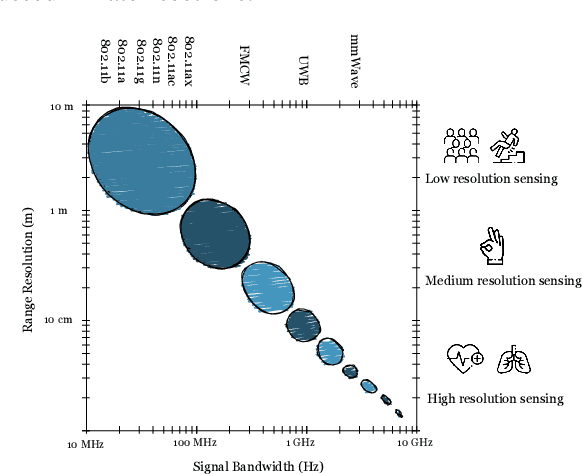
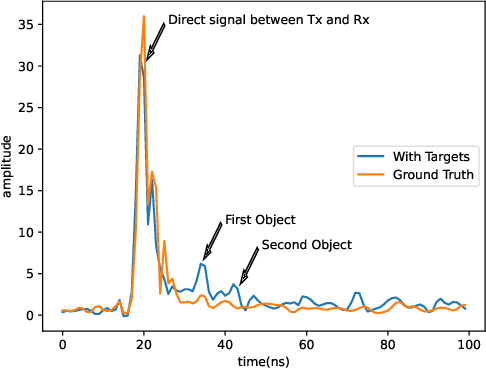
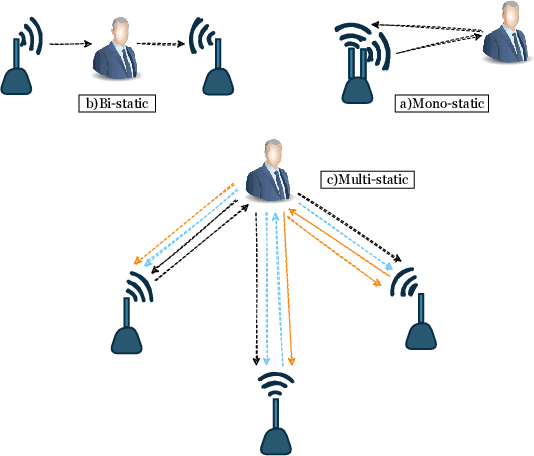
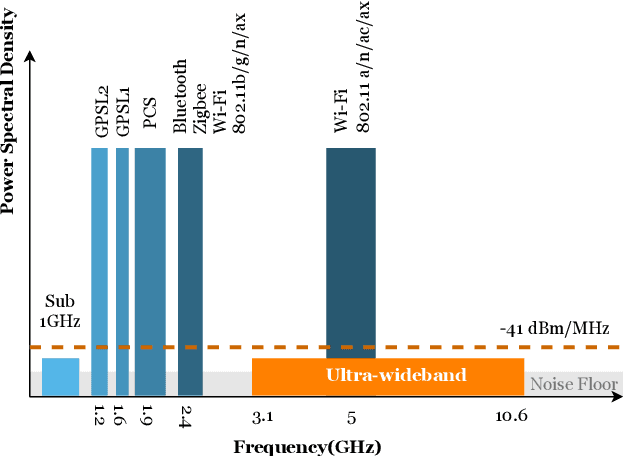
Abstract:Due to their large bandwidth, relatively low cost, and robust performance, UWB radio chips can be used for a wide variety of applications, including localization, communication, and radar. This article offers an exhaustive survey of recent progress in UWB radar technology. The goal of this survey is to provide a comprehensive view of the technical fundamentals and emerging trends in UWB radar. Our analysis is categorized into multiple parts. Firstly, we explore the fundamental concepts of UWB radar technology from a technology and standardization point of view. Secondly, we examine the most relevant UWB applications and use cases, such as device-free localization, activity recognition, presence detection, and vital sign monitoring, discussing each time the bandwidth requirements, processing techniques, algorithms, latest developments, relevant example papers, and trends. Next, we steer readers toward relevant datasets and available radio chipsets. Finally, we discuss ongoing challenges and potential future research avenues. As such, this overview paper is designed to be a cornerstone reference for researchers charting the course of UWB radar technology over the last decade.
Feature-Based Generalized Gaussian Distribution Method for NLoS Detection in Ultra-Wideband (UWB) Indoor Positioning System
Apr 14, 2023Abstract:Non-Line-of-Sight (NLoS) propagation condition is a crucial factor affecting the precision of the localization in the Ultra-Wideband (UWB) Indoor Positioning System (IPS). Numerous supervised Machine Learning (ML) approaches have been applied for NLoS identification to improve the accuracy of the IPS. However, it is difficult for existing ML approaches to maintain a high classification accuracy when the database contains a small number of NLoS signals and a large number of Line-of-Sight (LoS) signals. The inaccurate localization of the target node caused by this small number of NLoS signals can still be problematic. To solve this issue, we propose feature-based Gaussian Distribution (GD) and Generalized Gaussian Distribution (GGD) NLoS detection algorithms. By employing our detection algorithm for the imbalanced dataset, a classification accuracy of $96.7\%$ and $98.0\%$ can be achieved. We also compared the proposed algorithm with the existing cutting-edge such as Support-Vector-Machine (SVM), Decision Tree (DT), Naive Bayes (NB), and Neural Network (NN), which can achieve an accuracy of $92.6\%$, $92.8\%$, $93.2\%$, and $95.5\%$, respectively. The results demonstrate that the GGD algorithm can achieve high classification accuracy with the imbalanced dataset. Finally, the proposed algorithm can also achieve a higher classification accuracy for different ratios of LoS and NLoS signals which proves the robustness and effectiveness of the proposed method.
An Overview of Ultra-WideBand (UWB) Standards(IEEE 802.15.4, FiRa, Apple): Interoperability Aspects and Future Research Directions
Feb 04, 2022
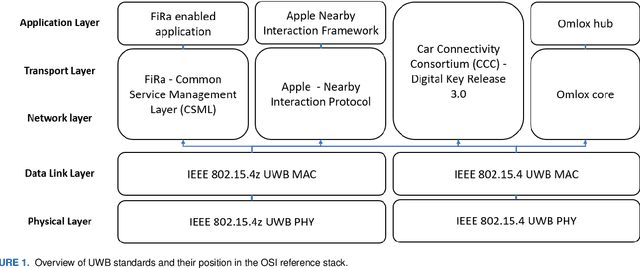


Abstract:The increasing popularity of ultra-wideband (UWB) technology for location-based services such as access control and real-time indoor track\&tracing, as well as UWB support in new consumer devices such as smartphones, has resulted in the availability of multiple new UWB radio chips. However, due to this increase in UWB device availability, the question of which (industry) standards and configuration factors impact UWB interoperability and compatibility becomes increasingly important. In this paper, the fundamentals of UWB compatibility are investigated by first giving an overview of different UWB radio chips on the market. After that, an overview of UWB standards and standardisation entities is given. Next, this overview is used to discuss the focus of these different standards and to identify the differences between them. We describe compatibility issues and associated interoperability aspects related to PHY, MAC, and upper layers. For the PHY layer, compatibility is possible for all UWB chips if the correct settings are configured. For the MAC layer, the implementation of the multiple access scheme as well as the localization technique is mostly proprietary. For the device discovery, several standards are currently being drafted. Finally, future challenges related to UWB interoperability are discussed.
 Add to Chrome
Add to Chrome Add to Firefox
Add to Firefox Add to Edge
Add to Edge